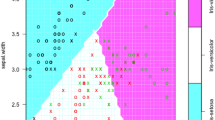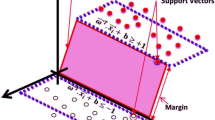Abstract
Cardiovascular disease is a most important reason for human death in modern society. Electrocardiogram (ECG) signal deals with valuable information about functioning of the heart. For that reason, ECG investigation signifies an efficient way to identification and treat different types of cardiac arrhythmia diseases. Nowadays various pattern classification methods has been developed for the classification of ECG signals. These classification methods helps to physician for diseases diagnosis. A multi-granulation rough set (MGRS) has become a new direction of rough set theory, which is based on multiple binary relations on the universe of discourse. In this present study, Multi-granulation rough set based classification approaches (Pessimistic Multi-Granulation Rough Set (PMGRS) and Optimistic Multi-Granulation Rough Set (OMGRS)) are applied to mine appropriate rules to explore better decision making process. The experiments were conducted on the ECG data from the Physionet arrhythmia database to classify five kinds of normal and abnormal signals. In the classification process, Feature extraction played an important role. And we have used two kinds feature extraction methods (1) Pan Tomkins (PT) feature extraction method. This method used to extract the morphological features are P, Q, R, S, T peak intervals, which is also used to determine heart rate. (2) Wavelet transform (WT) feature extraction method. This method used to extract the wavelet coefficients. Both two methods are successfully applied to (ECG signal) classification. The proposed multi-granulation rough set rule based classification methods is validated using the first 24 channel of the ECG signal records of the MIT-BITH arrhythmia database, and achieves finding high accuracies. Experimental results show that the proposed classification techniques significantly outperforms other well-known techniques.





Similar content being viewed by others
References
Korürek M, Doğan B (2010) ECG beat classification using particle swarm optimization and radial basis function neural network. Expert Syst Appl 37(12):7563–7569
Pasolli E, Melgani F (2010) Active learning methods for electrocardiographic signal classification. IEEE Trans Inf Technol Biomed 14(6):1405–1416
Melgani F, Bazi Y (2008) Classification of electrocardiogram signals with support vector machines and swarm particle optimization. IEEE Trans Inf Technol Biomed 12(5):667–677
Ubeyli ED (2009) Combining recurrent neural networks with eigenvector methods for classification of ECG beats. Digit. Signal Process. 19(2):320–329
Kohler BU, Henning C, Orglmeister R (2002) The principles of software QRS detection. IEEE Eng Med Biol 21(1):42–57
Christov I, Gómez-Herrero G, Krasteva V, Jekova I, Gotchev A, Egiazarian K (2006) Comparative study of morphological and time-frequency ECG descriptors for heartbeat classification. Med Eng Phys 28(9):876–887
Kania Michał, Rix Herve´, Fereniec Małgorzata, Zavala-Fernandez Heriberto, Janusek Dariusz, Mroczka Tomasz, Stix Gu¨nter, Maniewski Roman (2014) The effect of precordial lead displacement on ECG morphology. Med Biol Eng Comput 52:109–119
Homaeinezhad MR, Sabetian P, Feizollahi A, Ghaffari A, Rahmani R (2012) Parametric modelling of cardiac system multiple measurement signals: an open-source computer framework for performance evaluation of ECG, PCG and ABP event detectors. J Med Eng Technol 36:117–134
Kumar S, Senthil H Hannah, Inbarani (2015) Modified soft rough set based ecg signal classification for cardiac arrhythmias big data in complex systems. Springer International Publishing, Berlin, pp 445–470
Senthilkumar S, Hannah Inbarani H, Udhayakumar S (2014) Modified soft rough set for multiclass classification. Adv Intell Syst Comput 246:379–384
Senthil Kumar S, Hannah Inbarani H (2015) Optimistic multi-granulation rough set based classification for medical diagnosis. Procedia Comput Sci 47:374–382
Udhaya Kumar S, Hannah Inbarani H, Senthilkumar S (2013) Bijective soft set based classification of medical data, pattern recognition, informatics and medical engineering (PRIME), international conference, pp 517–521
Inbarani HH, Kumar SS, Azar AT, Hassanien AE (2014) Soft rough sets for heart valve disease diagnosis. In: Advanced conference on advanced machine learning technologies and applications. Proceedings 2nd international conference, AMLTA 2014, Cairo, Egypt, Nov 28–30 2014. Springer, pp 347–356. doi:10.1007/978-3-319-13461-1_33
Acampora Giovanni, Lee Chang-Shing, Wang Autilia Vitiello Mei-Hui (2012) Evaluating cardiac health through semantic soft computing techniques. Soft Comput 16:1165–1181
Pan J, Tompkins W (1985) A real-time QRS detection algorithm. IEEE Trans Biomed Eng 3:230–236
Moody GB, Mark RG (2001) The impact of the MIT-BIH Arrhythmia Database. IEEE Eng in Med and Biol 20(3):45–50
Xu W, Zhang X (2013) Zhang W (2013) Two new types of multiple granulation rough set. ISRN Appl Mathemat 2013:16. doi:10.1155/2013/791356
Xu W, Xiantao Zhang, Qiaorong Wang (2011) A generalized multi-granulation rough set approach. International Conference on Intelligent Computing. Springer, Berlin Heidelberg
Qian Y, Liang J, Yao Y, Dang C (2010) MGRS: a multi-granulation rough set. Inf Sci 180:949–970
Pawlak Zdzisław (1982) Rough sets. Int J Comput Inform Sci 11(5):341–356
Raghavan R (2013) Validation over basic set operations of internal structure of multi granular rough sets. Int J Latest Res Eng Comput (IJLREC) 1:34–42
Raghavan R, Tripathy BK (2011) On some topological properties of multi granular rough sets. Adv Appl Sci Res 2:536–543
Raghavan R, Tripathy BK (2013) On some comparison properties of rough sets based on multi granulations and types of multi granular approximations of classifications. Int J Intell Syst Appl 06:70–77
Karpagachelvi S, Arthanari M, Sivakumar M (2012) Classification of electrocardiogram signals with support vector machines and extreme learning machine. Neural Comput Appl 21:1331–1339
Mert A, Kılıc N, Akan A (2014) Evaluation of bagging ensemble method with time-domain feature extraction for diagnosing of arrhythmia beats. Neural Comput Appl 24:317–326
Kumari VSR, Rajesh Kumar P (2013) Fuzzy Unordered Rule Induction for Evaluating Cardiac Arrhythmia. Biomed Eng Lett 3:74–79
Ali Khazaee AE, Zadeh (2014) ECG beat classification using particle swarm optimization and support vector machine. Front Comput Sci. 8(2):217–231
Yuhua Qian A, Zhangb Hu, Sangb Yanli, Liang Jiye (2014) Multi granulation decision-theoretic rough sets. Int J Approximate Reasoning 55:225–237
Jiye Liang, Yuhua Qian, Chengyuan Chu, Deyu Li, Junhong Wang, Rough Set (2005) Approximation Based on Dynamic Granulation. In: Rough sets, fuzzy sets, data mining, and granular computing, lecture notes in computer science, 3641:701–708
Qibin Zhao, Liqing Zhang (2005) ECG feature extraction and classification using wavelet transform and support vector machines, international conference on neural networks and Brain, 2005. ICNN&B ‘05, 2:1089–1092
Rai HM, Trivedi A, Shukla S (2013) ECG signal processing for abnormalities detection using multi-resolution wavelet transform and artificial neural network classifier. Measurement 46(9):3238–3246
Sathishkumar EN, Thangavel K, Nishama A (2014) Comparative analysis of discretization methods for gene selection of breast cancer gene expression data. In: Computational intelligence, cyber security and computational models. Springer India, pp 373–378
Tripathy BK, Panda GK, Mitra A (2012) Incomplete multi granulation based on rough intuitionistic fuzzy sets. UNIASCIT 2(1):118–124
Kumar SS, Inbarani HH, Azar AT, Own HS, Balas VE, Olariu T (2016) Optimistic multi-granulation rough set-based classification for neonatal jaundice diagnosis. In: Soft computing applications, vol. 356. Springer, pp 307–317
Liu N, Lin Z, Koh Z, Huang GB, Ser W, Ong MEH (2011) Patient outcome prediction with heart rate variability and vital signs. J Signal Proc Syst 64(2):265–278
Jadhav Shivajirao, Nalbalwar Sanjay, Ghatol Ashok (2014) Feature elimination based random subspace ensembles learning for ECG arrhythmia diagnosis. Int J Soft Comput 18(3):579–587
Tong-Jun Li, Rough sets and general basic set assignments, lecture notes in computer science, 2011
Karaye IA., Saminu S, Özkurt N (2014) Analysis of cardiac beats using higher order spectra. In: IEEE 6th International conference on adaptive science & technology (ICAST), 29–31 Oct 2014, pp 1–8. doi:10.1109/ICASTECH.2014.7068145
Badiezadegan S, Soltanian-Zadeh H (2008) Design and evaluation of matched wavelets with maximum coding gain and minimum approximation error criteria for r peak detection in ECG. Int J Wavelets Multiresolut Inf Process 6(6):799–825
Wieben O, Afonso VX, Tompkins WJ (1999) Classification of premature ventricular complexes using filter bank features, induction of decision trees and a fuzzy rule-based system. Med Biol Eng Comput 37(5):560–565
Gogoi P, Bhattacharyya DK, Kalita JK (2013) A rough set–based effective rule generation method for classification with an application in intrusion detection. Int J Secur Netw 8(2):61–71
Engin M, Fedakar M, Engin EZ, Korürek M (2007) Feature measurements of ECG beats based on statistical classifiers. Measurement 40(9):904–912
Li X, Shu L, Hu H (2009) Kernel-based nonlinear dimensionality reduction for electrocardiogram recognition. Neural Comput Appl 18(8):1013–1020
Moskovitch R, Shahar Y (2015) Classification-driven temporal discretization of multivariate time series. Data Min Knowl Discov 29(4):871–913
Alajlan N, Bazi Y, Melgani F, Malek S, Bencherif MA (2014) Detection of premature ventricular contraction arrhythmias in electrocardiogram signals with kernel methods. Signal Image Video Process 8(5):931–942
Hassanien AE, Abraham A, Peters JF, Schaefer G (2009) Rough sets in medical informatics applications. In: Applications of soft computing. Springer Berlin Heidelberg, pp 23–30
Yang P, Li Q (2014) Wavelet transform-based feature extraction for ultrasonic flaw signal classification. Neural Comput Appl 24(3–4):817–826
El-Dahshan ESA (2011) Genetic algorithm and wavelet hybrid scheme for ECG signal denoising. Telecommun Syst 46(3):209–215
Qian YH, Liang JY, Dang CY (2010) Incomplete multi granulation rough set. IEEE Trans System Man Cy A 20:420–431
Yao YY (2001) Information Granulation and Rough Set Approximation. Int J Intell Syst 16(1):87–104
Pawlak Z, Skowron A (2007) Rudiments of rough sets. Inf Sci 177(1):3–27
Swiniarski RW, Skowron A (2003) Rough set methods in feature selection and recognition. Pattern Recogn Lett 24(6):833–849
Polkowski L, Skowron A (1998a). Rough sets in knowledge discovery, Vol. 1/2. Studies in Fuzziness and Soft Computing series, Physica–Verlag
Polkowski L, Skowron A (1998b). Rough sets and current trends in computing, LNAI 1424, Springer
Zadeh LA (1997) Toward a theory of fuzzy information granulation and its centrality in human reasoning and fuzzy logic. Fuzzy Sets Syst 90(2):111–127
Pei D, Xu Z-B (2004) Rough set models on two universes. Int J Gen Syst 33(5):569–581
Wang Xizhao, Zhexue Huang Joshua (2015) Editorial uncertainty in learning from big data. Fuzzy Sets Syst 258(1):1–4
Yao Yiyu, She Yanhong (2016) Rough set models in multi granulation spaces. Inf Sci 327:40–56
Luo Chuan, Li Tianrui, Yi Zhang, Fujita Hamido (2016) Matrix approach to decision-theoretic rough sets for evolving data. Knowl Based Syst 99(1):123–134
Zhang Junbo, Zhu Yun, Pan Yi, Li Tianrui (2016) Efficient parallel boolean matrix based algorithms for computing composite rough set approximations. Inf Sci 329(1):287–302
Li Shaoyong, Li Tianrui, Jie Hu (2015) Update of approximations in composite information systems. Knowl Based Syst 83:138–148
Chen Hongmei, Li Tianrui, Luo Chuan, Horng Shi-Jinn, Wang Guoyin (2015) A decision-theoretic rough set approach for dynamic data mining. IEEE Trans Fuzzy Syst 23(6):1958–1970
Chen Hongmei, Li Tianrui, Luo Chuan, Horng Shi-Jinn, Wang Guoyin (2014) A rough set-based method for updating decision rules on attribute values coarsening and refining. IEEE Trans Knowl Data Eng 26(12):2886–2899
Weihua Xu, Guo Yanting (2016) Generalized multi granulation double-quantitative decision-theoretic rough set. Knowl Based Syst 105(1):190–205
Yang Hai-Long, Liao Xiuwu, Wang Shouyang, Wang Jue (2013) Fuzzy probabilistic rough set model on two universes and its applications. Int J Approx Reason 54(9):1410–1420
Jie Hu, Li Tianrui, Chen Hongmei, Zeng Anping (2015) An incremental learning approach for updating approximations in rough set model over dual universes. Int J Intell Syst 30(8):923–947
Yiyu Yao (2007) Decision-theoretic rough set models, Rough Sets and Knowledge Technology, Second International Conference, RSKT 2007, Proceedings, LNCS(LNAI) 4481, pp. 1–12
Zhang Junbo, Li Tianrui, Chen Hongmei (2014) Composite rough sets for dynamic data mining. Inf Sci 257:81–100
Kumar SU, Inbarani HH (2016) Neighborhood rough set based ECG signal classification for diagnosis of cardiac diseases. Soft Comput 20:1–13
Acknowledgments
The second author would like to thank UGC (University Grant Commission), New Delhi, India for the financial support received under UGC Major Research Project No. F-41-650/2012 (SR). This article does not contain any studies with human participants or animals performed by any of the authors. The data used in this research is the ECG signals from the MIT–BIH (Massachusetts Institute of Technology—Boston’s Beth Israel Hospital) Arrhythmia database available on physionet website (http://www.physionet.org/physiobank/database).
Author information
Authors and Affiliations
Corresponding author
Rights and permissions
About this article
Cite this article
Senthil Kumar, S., Hannah Inbarani, H. Cardiac arrhythmia classification using multi-granulation rough set approaches. Int. J. Mach. Learn. & Cyber. 9, 651–666 (2018). https://doi.org/10.1007/s13042-016-0594-z
Received:
Accepted:
Published:
Issue Date:
DOI: https://doi.org/10.1007/s13042-016-0594-z




